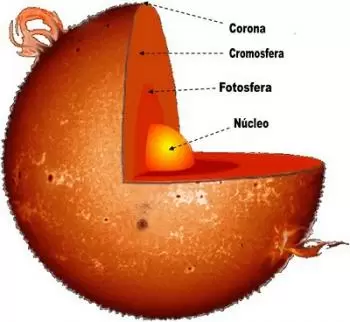
The solar atmosphere is composed of 3 layers that are the outer layers of the Sun that from the inside out are: the photosphere, the chromosphere and the solar corona.
All the energy in the solar atmosphere is energy generated in the Sun's core through nuclear fusion reactions at very high temperatures. These reactions are generated due to the high pressure caused by its own magnetic field and have been generated for more than 4600 billion years.
The energy that reaches the Earth's surface travels in the form of electromagnetic radiation at different wavelengths. Some of these particles, upon reaching our planet, follow the lines of the Earth's magnetic magnetic field, generating the famous northern lights.
Photosphere, the innermost layer of the Sun.
The photosphere is the visible surface of the Sun, that is, it is responsible for almost all of the visible light that the Sun emits into space. On its innermost side, it borders the convective zone of the Sun, and on its outermost side, with the chromosphere.
Observed in the telescope, the photosphere does not appear uniform, but appears to be made up of small, granular-looking cells, called grains of rice. These cells are separated by darker regions where the temperature is lower - sun spots.
It has been seen that hydrogen and helium together make up 96 to 99% of the photosphere, and that the rest is made up of the other chemical elements, of which about 60 have currently been identified.
The photosphere is composed mainly of atoms of hydrogen, helium.
Dimensions and temperature in the photosphere
The photosphere is approximately 400 to 300 km thick. The temperature is much lower than the 15 million degrees Celsius generated by the core of the Sun. In the photosphere, the temperature is between 7,500 kelvin and 4,700 kelvin, in the outermost part of the layer.
The average pressure of the photosphere is only a few hundredths of the atmospheric pressure at sea level. On the other hand, the density is only one ten millionth of the density of the Earth's atmosphere at sea level.
Chromosphere, intermediate layer of the Sun.
The chromosphere is the middle region of the solar atmosphere.
During eclipses of the Sun, in the moments before the phase of fullness, it appears as a very fine reddish arc, which surrounds the eclipsed disk of the Sun. Under normal conditions, that is, when there is no eclipse, it is not possible the observation of the chromosphere so that the light coming from the photosphere dims its brightness, much weaker.
Chromosphere dimensions and temperature
The chromosphere is supposed to be 2,000 to 3,000 km wide, but its upper end is covered by a forest of luminous gas springs, called spicules, making it difficult to determine exactly the true dimensions.
The density of the chromosphere decreases from the innermost regions to the outermost regions, but the temperature increases, at the same time, from 4,500 Kelvin to 100,000 Kelvin.
Corona, the outermost layer of the Sun
The corona is the outermost region of the total of the Sun's layers.
During total eclipses it appears as a whitish halo that surrounds the sun's eclipsed disk. Its width is a few million kilometers, but the total luminosity is only half the luminosity of the full moon.
Analogously to the chromosphere, it is also not possible to see it outside of total eclipses, because the powerful luminosity of the neighboring photosphere masks the presence. The density of matter at the base of the corona is 109 atoms / cm2, a value that is 10-10 times the density of the Earth's atmosphere at sea level.
At what temperature is the Sun's corona?
The temperature of the corona generally oscillates around a million kelvins, but in some of its regions it can be much higher.
For a long time the cause of these temperatures has been a mystery, but today it is believed that shock waves, caused by certain convective currents that occur in the photosphere, cause the heating of the corona and probably also of the chromosphere.